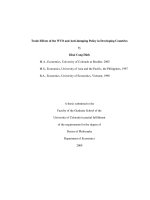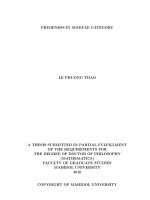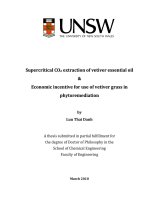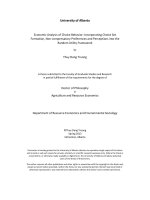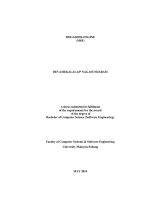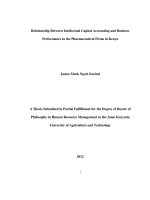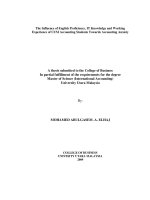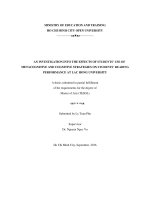a thesis submitted in partial fulfillment for the degree of doctor of philosophy in the school of chemical engineering faculty of engineering
Bạn đang xem bản rút gọn của tài liệu. Xem và tải ngay bản đầy đủ của tài liệu tại đây (1.48 MB, 210 trang )
Supercritical CO2 extraction of vetiver essential oil
&
Economic incentive for use of vetiver grass in
phytoremediation
by
Luu Thai Danh
A thesis submitted in partial fulfillment for
the degree of Doctor of Philosophy in the
School of Chemical Engineering
Faculty of Engineering
March 2010
ORIGINALITY STATEMENT
‘I hereby declare that this submission is my own work and to the best of
my knowledge it contains no materials previously published or written
by another person, or substantial proportions of material which have
been accepted for the award of any other degree or diploma at UNSW or
any other educational institution, except where due acknowledgement is
made in the thesis. Any contribution made to the research by others, with
whom I have worked at UNSW or elsewhere, is explicitly acknowledged
in the thesis. I also declare that the intellectual content of this thesis is
the product of my own work, except to the extent that assistance from
others in the project's design and conception or in style, presentation and
linguistic expression is acknowledged.’
Signed ……………………………………………..............
Date ……………………………………………..............
COPYRIGHT STATEMENT
‘I hereby grant the University of New South Wales or its agents the right to
archive and to make available my thesis or dissertation in whole or part in
the University libraries in all forms of media, now or here after known,
subject to the provisions of the Copyright Act 1968. I retain all proprietary
rights, such as patent rights. I also retain the right to use in future works
(such as articles or books) all or part of this thesis or dissertation.
I also authorise University Microfilms to use the 350 word abstract of my
thesis in Dissertation Abstract International (this is applicable to doctoral
theses only).
I have either used no substantial portions of copyright material in my thesis
or I have obtained permission to use copyright material; where permission
has not been granted I have applied/will apply for a partial restriction of
the digital copy of my thesis or dissertation.'
Signed ……………………………………………...........................
Date ……………………………………………...........................
AUTHENTICITY STATEMENT
‘I certify that the Library deposit digital copy is a direct equivalent of the
final officially approved version of my thesis. No emendation of content
has occurred and if there are any minor variations in formatting, they are
the result of the conversion to digital format.’
Signed ……………………………………………...........................
Date ……………………………………………...........................
ABSTRACT
Vetiver grass (VG) can be used for soil phytoremediation of various pollutants.
The plant is of high tolerance for extreme climatic variations and hostile soil conditions
and can produce high biomass. Vetiver can accumulate high concentrations of heavy
metals as well as absorb and promote biodegradation of organic wastes.
Essential oil extracted from roots of VG has aromatic and biological properties
employed in several applications. VG oil and its fractions are extensively used for
blending in oriental types of perfumes, cosmetics, foods and aromatherapy, and have
applicable potential as pharmaceutics, insecticides and herbicides.
The effect of Pb, Zn and Cu on vetiver oil yield and chemical composition was
investigated. Oil content and yield are not affected at low and moderate concentrations of
Cu and Zn. However, Pb has a significant detrimental effect on plant growth, oil yield and
composition. Vetiver oils extracted by hydrodistillation were free of heavy metals.
Results show that phytoremediation of Cu and Zn contaminated soils by vetiver can
generate revenue from the production of oil extracts.
To improve growth, oil yield and quality of VG grown on lead contaminated soils,
the addition of CaCO3 was investigated. Calcium treatment increased vetiver growth and
survival, but did not improve vetiver oil yield and chemical composition.
A response surface method was applied to optimize the extraction yields produced
by supercritical CO2 extraction (SCE). Operation at optimal conditions (190 bar, 50ºC
and 100 minutes) produced vetiver oil yield about four times higher than that of
hydrodistilation. Extraction pressure has a major linear effect on oil yield, whilst
temperature and time have a lesser impact.
i
The addition of ethanol increased extraction efficiency of SCE. At optimal
conditions of 190 bar, 50ºC and 15 vol% ethanol, ethanol-modified-SCE produced a yield
nearly double that of SCE without modifier operated at 190 bar and 50ºC. The operation
at 100 bar, 40ºC and 15 vol% ethanol had nearly the same yield as that of optimal
conditions. This finding allows extraction operated at low pressure and temperature.
Metals accumulated in vetiver roots were not co-extracted with essential oils by either
ethanol-modified SCE or SCE without modifier.
ii
ACKNOWLEDGEMENTS
I would like to express my deep gratitude to my supervisor, Prof Neil Foster, who allowed
me to work in his laboratory with full support. I specially appreciate his encouragement,
guidance, valuable suggestions and feedbacks during the course of my graduate study.
I would also like to thank my co-supervisors, Dr Paul Truong and Dr Raffaella Mammucari,
for many lengthy discussions, advices and encouragement throughout the study. I am
especially indebted to Dr Paul Truong for his hospitality during the period of my stay in
Brisbane and his time and energy for field work. I am also indebted to Dr Raffaella
Mammucari for her feedback on the writing of this thesis.
I would like to extend my gratitude to my co-workers, Roderick, Roshan, Adam, Wendy,
Jane and Grace for your friendship and valuable discussions. I am also grateful to Van Bong
Dang, Thanh Ngoc Vo and Peter Valtchev for their technical support. I also send my
gratitude to my friends, Tran Chau Duc and Dao Hong Quang, for their friendship and
support.
I would like to thank “cau Ba” and “mo Ba” for their support and hospitality during the time
we stayed with them. I am also grateful to “chu Tam” for his support and encouragement.
I would like to thank Ministry of Education and Training, Vietnam for financial support
during the time I studied abroad. The financial support from Gelita, Australia is highly
appreciated.
Finally, I would like to thank my family for their support and encouragement during the
course of study. Most of all, I would like to thank my wife, without her support this work
would not have been possible.
iii
Table of Contents
1
2
Abstract………………………………………………………………………....
Acknowledgements……………………………………………………………..
List of figures……………………………………………………………………
List of tables…………………………………………………………………….
Abbreviation……………………………………………………………………
List of publications……………………………………………………………..
Introduction…………………………………………………………………….
Literature review……………………………………………………………….
2.1. Vetiver grass, Vetiveria zizanioides: a choice plant for phytoremediation
of heavy metals and organic wastes……………………………………….
2.1.1
2.1.2
Introduction……………………………………………………….
Vetiveria zizanioides and its outstanding characteristics…………
2.1.2.1 Vetiveria zizanioides…………………………………….
2.1.2.2 Outstanding characteristics of Vetiveria zizanioides……
Morphological and genetic characteristics…………..
Agronomic characteristics…………………………...
Physiological characteristics ………………………...
Microorganism association ………………………….
2.1.2.3 Phytoremediation of heavy metals and organic wastes…
Heavy metals…………………………………………
Arsenic……………………………………………
Boron……………………………………………..
Cadmium………………………………………….
Copper…………………………………………….
Chromium………………………………………...
137
Cesium and 90Strontium……………………….
Lead………………………………………………
Zinc……………………………………………….
Multi-heavy metals………………………………..
Phytoremediation potential of vetiver versus
other plant species………………………………..
Organic Wastes………………………………………
Phenol…………………………………………….
2,4,6-Trinitroluene………………………………..
Ethidium bromide…………………………………
Benzo[a]pyrene…………………………………...
iv
i
iii
viii
x
xii
xiii
1
5
5
6
7
7
8
8
10
10
15
16
16
16
18
18
19
21
22
22
28
30
31
35
35
35
36
37
3
Petroleum hydrocarbon…………………………..
Atrazine…………………………………………..
2.1.3 Conclusion………………………………………………………..
2.1.4 References…………………………………………………………
2.2. Vetiver essential oil……………………………………………………….
2.2.1 Introduction………………………………………………………
2.2.2 Production ……………………………………………………….
2.2.3 Properties... ………………………………………………………
2.2.4 Chemical composition …………………………………………...
2.2.5 Applications………………………………………………………
2.2.5.1 Perfumery……………………………………………….
2.2.5.2 Aromatherapy…………………………………………..
2.2.5.3 Insecticides………………………………………………
2.2.5.4 Herbicides……………………………………………….
2.2.5.5 Antioxidant activity……………………………………..
2.2.5.6 Anticancer activity……………………………………....
2.2.5.7 Antimicrobial activity…………………………………..
2.2.5.8 Other uses……………………………………………….
2.2.7 References…………………………………………………………
2.3 Supercrtical fluid extraction ………………………………………………
2.3.1 Introduction……………………………………………………….
2.3.2 Characteristics of supercritical fluid extraction…………………..
2.3.3 Selection of the operating conditions…………………………….
2.3.3.1 Pressure………………………………………………….
2.3.3.2 Temperature…………………………………………….
2.3.3.3 CO2 flow rate……………………………………………
2.3.3.4 Particle size……………………………………………...
2.3.3.5 Time…………………………………………………….
2.3.3.6 Modifiers or co-solvents………………………………..
2.3.4 Optimization of operating conditions…………………………….
2.3.5 References…………………………………………………………
Economic incentive for applying vetiver grass to remediate lead, copper
and zinc contaminated soils………………………………………………….....
37
37
38
40
51
51
51
53
53
54
54
55
55
57
57
58
58
58
60
64
64
66
67
67
68
68
69
69
70
71
72
3.1
3.2
79
81
81
81
83
83
Introduction……………………………………………………………….
Materials and methods…………………………………………………….
3.2.1 Plant materials…………………………………………………….
3.2.2 Soil treatments……………………………………………………
3.2.3 Plant cultivation…………………………………………………...
3.2.4 Extraction…………………………………………………………
v
78
3.2.5
4
Gas-chromatographic and Gas chromatography-Mass
spectrometry analysis……………………………………………
3.2.6 Statistical analysis……………………………………………….
3.3 Results and discussion…………………………………………………...
3.3.1 Soil characteristics………………………………………………
3.3.2 Growth performance…………………………………………….
3.3.3 Content and yield of vetiver oil………………………………….
3.3.4 Heavy metal contents in vetiver roots and shoots……………….
3.3.5 Chemical components of vetiver essential oil…………………...
3.4 Discussion………………………………………………………………..
3.5 Conclusion……………………………………………………………….
3.6 References………………………………………………………………..
Effect of calcium on growth performance and essential oil of vetiver grass
grown on lead contaminated soils……………………………………………
4.1
4.2
5
Introduction……………………………………………………………..
Materials and methods…………………………………………………..
4.2.1 Plant materials…………………………………………………...
4.2.2 Soil treatments…………………………………………………..
4.2.3 Plant cultivation…………………………………………………
4.2.4 Extraction……………………………………………………….
4.2.5 Gas-chromatographic and Gas chromatography-Mass
spectrometry analysis……………………………………………
4.2.6 Statistical analysis……………………………………………….
4.3 Results and discussion…………………………………………………..
4.3.1 Soil properties……………………………………………………
4.3.2 Effect of lime on soil pH…………………………………………
4.3.3 Vetiver growth performance……………………………………..
4.3.4 Heavy metals in roots and shoots of vetiver……………………..
4.3.5 Oil content and oil yield………………………………………….
4.3.6 Chemical components of vetiver essential oil……………………
4.4 Conclusion………………………………………………………………..
4.5 References…………………………………………………………………
Response surface method applied to supercritical CO2 extraction of
Vetiveria zizanioides essential oil……………………………………………….
5.1 Introduction………………………………………………………………
5.2 Materials and methods…………………………………………………....
5.2.1 Plant material preparation………………………………………..
5.2.2 Soxhlet extraction…………………………………………………
5.2.3 Hydro-distillation…………………………………………………
vi
84
85
86
86
87
88
89
91
94
98
99
104
105
108
108
108
109
109
110
110
111
111
111
112
114
115
116
120
121
125
126
129
129
129
130
5.2.4
5.2.5
5.2.6
5.2.7
5.2.8
6
Supercritical CO2 extraction…………………………………….
Experimental design…………………………………………….
Kinetic study…………………………………………………….
Yield calculation………………………………………………...
Gas chromatography and gas chromatography-mass spectrometry
analysis…………………………………………………………..
5.3 Results and discussion…………………………………………………..
5.3.1 Optimization of SCF extractions………………………………..
5.3.2 Kinetic study…………………………………………………….
5.3.3 Chemical components of SCE vetiver extract…………………..
5.3.3.1 Khusimol………………………………………………
5.3.3.2 Zizanoic acid…………………………………………..
5.3.4 Comparison with conventional extraction methods……………
5.4 Conclusion………………………………………………………………
5.5 References………………………………………………………………..
Extraction of Vetiver essential oil by ethanol modified supercritical carbon
dioxide……………………………………………………………………………
6.1
6.2
Introduction………………………………………………………………..
Materials and methods…………………………………………………….
6.2.1 Plant material preparation…………………………………………
6.2.2 Extraction………………………………………………………….
6.2.3 Experimental design………………………………………………
6.2.4 Gas chromatography and gas chromatography–mass spectrometry
analysis…………………………………………………………….
6.2.5 Heavy metal analysis……………………………………………...
6.2.6 Statistical analysis…………………………………………………
6.3 Results and discussion…………………………………………………….
6.3.1 Kinetic study………………………………………………………
6.3.2 Effect of operating parameters on oil yield and optimization of
ethanol-modified-SCE…………………………………………....
6.3.3 Chemical components of ethanol-modified SCE extracts………..
6.3.4 Comparison with hydrodistillation and pure SCE………………..
6.3.5 Heavy metals contents in SCF extracts……………………………
6.4 Conclusion…………………………………………………………………
6.5 References…………………………………………………………………
7 Conclusions and Recommendations……………………………………………
7.1 Summary of conclusions………………………………………………….
7.2 Recommendations…………………………………………………………
Appendix A………………………………………………………………………….
vii
130
131
134
134
135
136
136
143
144
147
149
150
153
154
158
159
162
162
162
164
165
166
166
167
167
168
176
179
180
183
184
187
187
189
190
List of Figures
Vetiveria zizanioides grass from left to right: mature plant, thick hedge, deep and
extensive root system………………………………………………………………...
9
2.2.
Phase diagram of a pure compound (Smith et al., 1996)…………………………….
65
4.1.
Soil pH under effect of different Ca treatments……………………………………...
112
5.1.
Schematic diagram of SCF extraction. V1, V2, V3: stopping valve; F: filter; CV:
check valve, HC: heating coil; E: extraction vessel; CH: circulating heater; PM:
pressure meter; MV: micro-metering valve………………………………………….
Central composite design with three operating conditions of supercritical fluid
extraction…………………………………………………………………………….
131
5.3.
Goodness of fit of empirical model………………………………………………….
138
5.4.
Response surface plot showing the effect of pressure and temperature on oil yield at
extraction time of 50 minutes………………………………………………………... 139
5.5.
Response surface plot showing the effect of temperature and time on oil yield at
fixed pressure of 190 bar…………………………………………………………….. 140
5.6.
Response surface plot showing the effect of pressure and time on oil yield at fixed
temperature of 50°C………………………………………………………………….
141
5.7.
Scanning electronic microscopy of dry vetiver root: localization of oil glands……..
142
5.8.
Yield of vetiver oil extracted by SCE as a function of the total amount of CO2 used
at different operating conditions……………………………………………………..
144
Response surface plot showing the effect of pressure and temperature on khusimol
content at the extraction time of 50 minutes…………………………………………
149
2.1.
5.2.
5.9.
132
Schematic diagram of ethanol-modified SCF extraction. V1-V3: stopping valve,
MV1-MV2: micro-metering valve, HC: heating coil, E: extractor, SM: static mixer,
CV: check valve, CH: circulating heater, PM: pressure meter………………………
The cumulative yield of vetiver extracts over time at the fixed operating conditions
of 145 bar, 45C and different amounts of added ethanol (0, 5, 10 and 15%)………
168
6.3.
Goodness of fit between the experimental and predicted yields…………………………….
170
6.4.
The effect of pressure and the concentration of ethanol on oil yield at the extraction
temperature of 50°C………………………………………………………………….
172
6.1.
6.2.
viii
164
6.5.
6.6.
The effect of temperature and the concentration of ethanol on oil yield at the
extraction pressure of 100 bar..………………………………………………………
174
The effect of pressure and temperature on oil yield at the ethanol concentration of
5%...............................................................................................................................
175
ix
List of Tables
2.1.
Threshold levels of heavy metals to vetiver growth (Truong 1999b) based on single
element experiments………………………………………………………………… 12
2.2.
Concentrations of heavy metals accumulated in VZ roots and shoots (Truong,
1999b)……………………………………………………………………………….
14
2.3.
Ratio of accumulated Pb in vetiver shoots over roots in different experiments…….
25
2.4.
Effect of EDTA on Pb uptake and translocation ratio of VZ……………………….
26
2.5.
The level of Zn in soils and in VZ roots and shoots………………………………..
29
2.6.
Phytoremediation ability of Vetiveria zizanioides and other heavy metal
hyperaccumulators…………………………………………………………………..
33
3.1.
Concentrations of nutrients (mg kg-1 dry soil) added into Pb, Cu and Zn treatments.
82
3.2.
Physical and chemical properties of river sand……………………………………..
86
3.3.
The dry bimomass of VG grown on soils with different concentrations of lead,
copper and zinc for 7 months………………………………………………………... 87
3.4.
Yield of VG oil under effect of lead, zinc and copper………………………………. 89
3.5.
Level of Pb, Cu and Zn in VG shoots, roots and hydro-distilled roots……………...
90
3.6.
Chemical components of vetiver essential oil under effect of different treatments of
Pb, Cu and Zn………………………………………………………………………..
92
Growth characteristics of vetiver grass grown on lead contaminated soils under
different treatments of calcium………………………………………………………
113
4.2.
Level of heavy metals in leaves of Vetiver grown under different Ca treatments…..
115
4.3.
The oil content and yield of vetiver grass…………………………………………… 116
4.4.
Chemical composition of vetiver essential oil under different treatment of Ca……..
4.1.
x
118
5.1.
Size ranges of roots particles………………………………………………………...
129
5.2.
Coded and uncoded levels of independent variables………………………………………..
133
5.3.
Central composite design with coded and uncoded levels of independent variables
and experimental yield…………………………………………………………………….
136
5.4.
Regression coefficients and corresponding t and P-values for vetiver oil yield…….. 137
5.5.
Chemical components of vetiver oils extracted by SCE at different operating
conditions, hydrodistillation and hexane extraction…………………………………
145
5.6.
Regression coefficients and corresponding t and P-values for khuismol content......
148
5.7.
Yields obtained by hydro-distillation, solvent and supercritical fluid extraction of
Vetiver essential oil………………………………………………………………….
151
6.1.
Coded and uncoded levels of independent variables………………………………..
165
6.2.
Central composite design with coded and uncoded levels of independent variables, and
experimental yield………………………………………………………………………….
169
6.3.
Regression coefficients and corresponding t and P-values for vetiver oil yield…….
170
6.4.
Chemical compositions of vetiver oil extracted by hydrodistillation, supercritical
CO2 and ethanol modified supercritical CO2……………………………………….
177
Yield of vetiver oil extracted by hydrodistillation, pure SCE and ethanol-modified
SCE………………………………………………………………………………….
180
Metal contents of vetiver roots before and after extraction by pure SCE and ethanol
modified SCE……………………………………………………………………….
182
6.5.
6.6.
xi
Abbreviation
VG
Vetiver grass
VZ
Vetiveria zizanioides
SCE
Supercritical carbon dioxide extraction
SFE
Supercritical fluid extraction
SCF
Supercritical fluid
SC-CO2
Supercritical carbon dioxide
RSM
Response surface method
CCD
Central composite design
As
Arsenic
Cd
Cadmium
Cr
Chromium
Cu
Copper
Hg
Mercury
Ni
Nickel
Pb
Lead
Se
Selenium
Zn
Zinc
137
137
90
Cs
Strontium
TR
90
Cesium
Sr
The translocation of metals from roots to shoots
xii
List of publications
Published papers
Luu Thai Danh, Raffaella Mammucari, Paul Truong and Neil Foster. 2009. Response
surface method applied to supercritical carbon dioxide extraction of Vetiveria zizanioides
essential oil. Chemical Engineering Journal, 155, 617-626.
Luu Thai Danh, Paul Truong, Raffaella Mammucari, Tam Tran and Neil Foster. 2009.
Vetiver grass, Vetiveria zizanioides: A choice plant for phytoremediation of heavy metals
and organic wastes. International Journal of Phytoremediation 11, 664- 691.
Luu Thai Danh, Paul Truong, Raffaella Mammucari and Neil Foster. 2010. Economic
incentive for applying vetiver grass to remediate lead, copper and zinc contaminated soils.
International Journal of Phytoremediation. Article in Press.
Luu Thai Danh, Paul Truong, Raffaella Mammucari and Neil Foster. Effect of calcium on
growth performance and essential oil of vetiver grass grown on lead contaminated soils.
International Journal of Phytoremediation. Article in Press.
Submitted papers
Luu Thai Danh, Raffaella Mammucari, Paul Truong and Neil Foster. Extraction of Vetiver
essential oil by ethanol modified supercritical carbon dioxide. Chemical Engineering
Journal.
Conferences
Luu Thai Danh, Paul Truong, Raffaella Mammucari and Neil Foster. Effect of calcium on
growth performance and essential oil of vetiver grass grown on lead contaminated soils. 6th
International Conference on Phytotechnologies, St. Louis, Missouri, USA, December 1-4,
2009.
xiii
Luu Thai Danh, Raffaella Mammucari, Paul Truong and Neil Foster. Extraction of Vetiveria
zizanioides esential oil by supercritical carbon dioxide. 11th European Meeting on
Supercritical Fluids, Barcelona, Spain, May 4-7, 2008.
Luu Thai Danh, Raffaella Mammucari, Paul Truong and Neil Foster. Optimization of
essential oil extraction from Vetiveria zizanioides using supercritical CO2. American
Institute of Chemical Engineers Annual Meeting, Salt Lake City, Utah, USA, November 4-9,
2007.
xiv
1. Introduction
An increasingly industrialized global economy and rapid rise in world population
over the last century have led to dramatically elevated releases of toxic wastes into the soil
environment. These pollutants can be readily passed onto human beings through the food
chain due to soil-to-plant transfer. Consequently, there is a growing global awareness about
human health and ecological threats caused by soil pollution.
Soil pollution is often treated by conventional methods, such as physical, chemical
and biological methods. Physical treatments involve removal from contaminated sites (soil
excavation), deep burial (land filling) and capping. Chemical methods use strong acids and
chelators to wash polluted soils. Biological methods employ micro-organisms for pollutant
removal. These approaches are expensive, impractical and at times impossible to carry out,
as the volume of contaminated materials is very large. Furthermore, they irreversibly affect
soil properties, destroy biodiversity and may render the soil useless as a medium for plant
growth.
An alternative method called phytoremediation has been developed recently by using
a diverse collection of plant-based technologies from either naturally occurring or
genetically engineered plants to clean contaminated soils. It represents an environmentally
friendly and cost effective technology and attracts the attention of publics and scientists
worldwide. However, the application of this technology is limited due to several reasons.
First of all, this method is a time consuming process due to the selection of low biomass
plants. Secondly, plants survival under the hostile conditions of contaminated soils can be
unsatisfactory. Finally, plants the accumulation of high concentrations of pollutants in the
biomass is not always possible.
Among the plants used in phytoremediation, vetiver grass (Chrysopogon zizanioides
(L.) Roberty, syn. Vetiveria zizanioides (L.) Nash) satisfies nearly all criteria required for an
1
effective phytoremediation. Vetiver grass (VG) is a fast growing plant and produces high
levels of biomass. It can tolerate well a wide range of hostile conditions at contaminated
sites. Importantly, it can accumulate high concentrations of heavy metals, particularly lead
and zinc, in the roots. The special characteristics that make Vetiveria zizanioides a very
promising candidate for phytoremediation are discussed in Chapter 2, part 2.1.
Essential oil extracted from the roots of VG has aromatic and biological properties
that can be employed in a wide range of applications. VG oil and its fractions are
extensively used for blending in oriental types of perfumes, cosmetics and aromatherapy.
Recently, the discovery of biological properties of vetiver essential oil, such as antifungal,
antibacterial, anticancer, anti-inflammatory and antioxidant activities, opens the way to
application in the pharmaceutical industry. VG extracts can also be used in food and
beverages as aromatizing agents. Insecticidal activities of VG oil against cockroaches, flies
and Formosan subterranean termite have been discovered. Production, properties, chemical
compositions and uses of VG oil are revised in Chapter 2, part 2.2.
Vetiver essential oil is traditionally extracted by hydro-distillation, steam distillation
and solvent extraction. However, hydro and steam distillation have several disadvantages,
such as incomplete extraction of essential oils from plant materials, high operating
temperatures with the consequent breakdown of thermally labile components, the promotion
of hydration reactions of chemical constituents, and requirement for a post-extraction
process to remove water. Solvent extraction overcomes the drawbacks of distillation, but has
the major disadvantage of solvent residue in the extracts. Supercritical fluid extraction
(SFE), a novel and environmentally benign separation technology, represents a green and
valuable alternative to the conventional extraction methods for the production of natural
extracts. Advantages, selection of operating conditions and optimization of SFE process are
revised in Chapter 2, part 2.3.
The objectives of this study are to investigate the potential of promoting the
application of vetiver grass for phytoremediation of heavy metal contaminated soils,
specifically lead, zinc and copper, via cash return from essential oil production, and to study
2
the use of supercritical CO2 for extraction of vetiver essential oil. To obtain these goals, the
following work was performed:
Investigation of the effect of heavy metals on vetiver essential oil yield and composition
(Chapter 3):
The application of VG for phytoremediation or revegetation of soils contaminated by
heavy metals can be strongly promoted by economic return from VG extracts. However
concerns may rise about contamination of oil extracts by heavy metals. Lead, zinc and
copper are the most common pollutants of the soil environment and they are accumulated in
roots of vetiver grass at high concentrations. The study was carried out to determine whether
or not high concentrations of these metals accumulated in roots can affect yield, chemical
compositions as well as contaminate vetiver essential oil extracted by hydrodistillation.
Investigation of the effect of calcium on growth performance and essential oil of vetiver
grass grown on lead contaminated soils (Chapter 4):
The study in Chapter 3 showed that the survival rate, and both yield and chemical
composition of oil from VG were adversely affected by high levels of lead in soils. The
toxic effect of heavy metals on plant growth can be reduced by the addition of calcium.
Therefore, the objective of this study was to investigate the effect of calcium (added as
CaCO3) on VG growth and survival rate as well as its effect on yield and chemical
composition of oil from VG grown on highly lead contaminated soils.
Optimizion of supercritical CO2 extraction (Chapter 5):
Efficiency of supercritical CO2 extraction (SCE) depends on several variables,
including extraction temperature, pressure and time. To investigate the effect of these
parameters on vetiver oil yield and optimize them for a high yield, the Response Surface
Method using a Central Composite Design (RMS-CCD) was employed. The yield and
chemical compositions obtained from SCE were compared to those obtained from
conventional extraction methods (hydro distillation and solvent extraction).
3
Optimization of ethanol-modified supercritical CO2 extraction (Chapter 6):
Supercritical CO2 is a non-polar solvent that can not solubilise compounds without
or with weak polarity, resulting in low extraction efficiency. The addition of ethanol to
supercritical CO2 forms a solvent with higher polarity leading to potential improvements in
extraction efficiencies. The objectives of this study were to investigate the effect of three
operating conditions of ethanol modified CO2 extraction, namely pressure, temperature and
amount of added ethanol, on yield and chemical composition of vetiver essential oil, and to
optimize these conditions for a high oil yield by using the RMS-CCD method. In addition,
the study also addressed the risk of heavy metal contamination of VG extracts. The study
also investigated whether pure SCE (without co-solvent) and ethanol-modified SCE coextract heavy metals with essential oil from vetiver roots.
4
2. Literature review
2.1. Vetiver grass, Vetiveria zizanioides: a choice plant for
phytoremediation of heavy metals and organic wastes
Abstract
Glasshouse and field studies showed that Vetiver grass (VG) can produce high biomass
(>100 tone ha-1year-1) and tolerate extreme climatic variation such as prolonged drought,
flood, submergence and temperatures (-15° to 55°C), soils high in acidity and alkalinity (pH
3.3-9.5), high levels of Al (85% saturation percentage), Mn (578 mg kg-1), soil salinity
(ECse 47.5 dS m-1), sodicity (ESP 48%), and a wide range of heavy metals (As, Cd, Cr, Cu,
Hg, Ni, Pb, Se, and Zn). Vetiver can accumulate heavy metals, particularly lead (shoot 0.4
wt% and root 1 wt% on dry basis) and zinc (shoot and root 1 wt% on dry basis). The
majority of heavy metals is accumulated in roots thus VG is suitable for phytostabilization,
and for phytoextraction with addition of chelating agents. Vetiver can also absorb and
promote biodegradation of organic wastes (2,4,6-trinitroluene, phenol, ethidium bromide,
benzo[a]pyrene, atrazine). Although VG is not as effective as some other species in heavy
metal accumulation, very few plants have such a wide range of tolerance to extremely
adverse conditions of climate and growing medium (soil, sand, and tailings). All these
special characteristics make VG a plant of choice for phytoremediation of heavy metals and
organic wastes.
Note: the content of section 2.1 was published in
Luu Thai Danh, Paul Truong, Raffaella Mammucari, Tam Tran and Neil Foster. 2009.
Vetiver grass, Vetiveria zizanioides: A choice plant for phytoremediation of heavy metals
and organic wastes. Inter. J. Phyt. 11, 664- 691.
5
2.1.1. Introduction
The rapid increase in population coupled with fast industrialization and intensive
agricultural practices causes serious environmental problems, including the production and
release of considerable amounts of toxic wastes into the soil environment (Xuliang et al.,
2007). According to a report of the US Environmental Protection Agency (EPA, 2007),
there are more than 40,000 contaminated sites in the Unites States alone. Soil pollutants can
be classified into two main groups: inorganic and organic. The major components of
inorganic pollutants are heavy metals, such as lead, arsenic, cadmium, copper, zinc, nickel,
and mercury, which are continuously added into the environment via disposal of urban
sewage sludge and industrial wastes in agricultural soils and via agrochemical usage (Khan,
2005). These pollutants, together with radionuclides released through various human
activities (mining and milling of nuclear fuel, testing of nuclear weapons, occasional nuclear
disasters), accumulate in the soils, and can be readily passed onto human beings through the
food chain due to soil-to-plant transfer of metals and radionuclides (Khan, 2005; Shaw and
Bell, 1991). In addition, vast areas of soils around the world are contaminated with organic
pollutants, mainly pesticides, petroleum hydrocarbons, polycyclic aromatic hydrocarbons,
and explosives.
In recent years, public concerns relating to human health and ecological threats
caused by soil pollution have led intensive research of new economical remediation
technologies. Conventional methods used for treatment of contaminated soils, namely
chemical, physical, and microbiological methods, are costly to install and operate. A new
green technology has been developed, called phytoremediation, which utilizes plants to
decontaminate soil, water and air environment (Prasad, 2003; Salt et al., 1998; Chaney et al.,
1997), and it is growing of importance in controlling soil pollution. Phytoremediation is
clean, simple, cost effective, non-environmentally disruptive (Wei and Zhou, 2004; Zhou
and Song, 2004), and most importantly, its by-products can find a range of other uses
(Truong, 2003).
6
The application of phytoremediation for pollution control, however, has several
limitations that require further research on plant and site-specific soil conditions.
Phytoremediation is mainly confined to the area occupied by the root systems, and as the
consequence, small plants with low yields and reduced root systems do not support efficient
phytoremediation and most likely do not prevent the leaching of contaminants into ground
water. In addition, non-perennial plants, particularly those with slow growth and low
biomass production require a long-term commitment for remediation. Environmental
conditions also determine the efficiency of phytoremediation as the survival and growth of
plants are adversely affected by extreme environmental conditions, toxicity, and the general
conditions of soil in contaminated lands (Northwestern University, 2007). Finally, different
types of pollutants in soils and water require different types of plants for phytoremediation,
which adds to the complexity of the technology and requires a wide range of research
activities prior to the release of specific plants for commercialization.
Vetiveria zizanioides (L.) Nash, is one of the very few plants, if not the only one that
has the potential to meet all the criteria required for phytoremediation (Truong, 2003).
Therefore, it has received a great interest from scientists and the wider public for the
removal of a wide range of contaminants from soil in recent years. In this review, the special
characteristics and potentials that make Vetiveria zizanioides a very promising candidate for
phytoremediation are discussed.
2.1.2. Vetiveria zizanioides and its outstanding characteristics
2.1.2.1. Vetiveria zizanioides
Vetiver grass, Vetiveria zizanioides (L.) Nash, syn. Chrysopogon zizanioides (L.)
Roberty, belongs to the Poaceae family, subfamily of Panicoideae, tribe Andropogonae and
subtribe Sorghina, and the genus includes ten species (Bertea and Camusso, 2002). Vetiver
grass originated in the Indian sub-continent is common to flood plains and stream banks, but
7
can also be found throughout the tropical and subtropical regions of Africa, Asia, America,
Australia, and Mediterranean Europe (Maffei, 2002).
Among the Vetiver species, Vetiveria zizanioides (VZ) is the most valuable in term
of economics. In fact, essential oil extracted from its roots has been used for a long time in
perfumers, medicine, and other areas of applications. The use of VZ for land protection
purposes has long been practiced in tropical and subtropical countries, but its advantages,
namely low cost, effectiveness and ease of soil and water conservation, only emerged in the
late 1980s (Truong, 2002). Through the understanding of the extraordinary physiological
and morphological characteristics of VZ and their roles in soil and water conservation,
researchers found the distinctive attributes, which make VZ particularly suitable for
environmental protection purposes (Truong, 2000).
2.1.2.2. Outstanding Characteristics of Vetiveria zizanioides
Morphological and genetic characteristics
VZ is a tall, tufted, perennial, scented grass, with a straight and stiff stem, long
narrow leaves and a lacework root system that is abundant, complex, and extensive
(Chomchalow, 2001). The root system can reach 3-4 meters in the first year of planting
(Hengchaovanich, 1998) and acquires a total length of 7 meters after 36 months (Lavania,
2003). The features of the root system support the survival of VZ under extreme drought
conditions as it can utilize deep soil moisture. The root system prevents VZ from
dislodgement under high velocity flows (Hengchaovanich, 1999; Hengchaovanich and
Nilaweera, 1998). Stiff and erect stems of VZ, up to 2-m high, can stand also in relatively
deep-water flow (Truong, 2002). The peculiarity of VZ's root system ensures high contact
surfaces with soil particles and, consequently, efficient phytoremediation and possible
prevention of leaching of contaminants into ground waters (Figure 2.1).
8
Figure 2.1. Vetiveria zizanioides grass from left to right: mature plant, thick hedge, deep
and extensive root system.
An important aspect of plant use for bioengineering or environmental protection in
non-native environments is the prevention of introducing hard-to-control weeds. VZ has
flowers but setting no seeds, so the potential to become a weed is very low. Despite the fact
that VZ was introduced from India into Fiji more than 100 years ago, and has been widely
used for water and soil conservation over the past 60 years, there are no reports indicating
that it is a weed in this new environment (Truong and Creighton, 1994). In addition, a study
conducted in Australia for eight years showed that VZ is sterile under various growing
conditions (Truong, 2002). In 2007, USDA carried out a new risk assessment of non fertile
VZ cultivars from south India through the Pacific Island Ecosystem at Risk (PIER), typified
by Sunshine (US) and Monto (Australia) genotypes. A rating system was adopted based on
the Australian/New Zealand weed risk assessment protocol, modified for Hawaii
( The protocol is very strict and thorough and
considers a score as high as two being acceptable for safe introduction. According to such a
protocol, VZ was rated minus eight.
One of the peculiar characteristics of VZ is its ability to form a thick hedge when
planted close together (Figure 2.1). A VZ hedge can stand up to water flow of 0.6 m depth,
forming a living barrier, which impedes and spreads run-off water. The VZ hedge also acts
as a very effective filter for trapping sediments and agricultural chemicals (Truong, 2002)
before they reach water courses.
9
